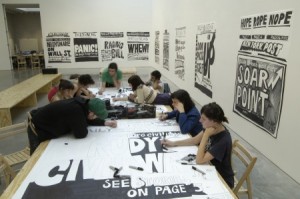For ‘Art on Paper’ Magazine

Visitors were in for a surprise at Mary Boone Gallery recently, when the normally frosty atmosphere was melted by the folksy artwork of artist Aleksandra Mir and her team of assistants. Music blared from a boom box, while collectors rubbed shoulders with young hipsters in what looked like an art studio. In a back office, cordoned off but publicly visible, Mir hand-copied onto huge sheets of paper the front pages from hometown tabloids the Post and the Daily News, dating from 1986 to 2000. When she was done, her drawings were transferred to the main gallery where a Sharpie-wielding team of young artists and students diligently filled in her outlines. All in all, some two-hundred drawings from approximately ten thousand front pages were generated.
Mir claimed that she couldn’t care less about the gallery’s newly congenial or keyed down ambience, saying, “That’s the subject that interests me the least. I’m not interested in institutional critique but in having been a citizen of this town.” Yes, it’s true that the project broadcast a fond nostalgia for the city that the Polish born, Sweden-raised artist recently left after a fifteen-year stay. In some the headlines emphasized the entertainment value of the New York tabloids: a ‘Burger Murder’ poisoning was treated with as much import as a ‘Milk War’ waged on grocery prices. In another group, the headlines were linked by money— ‘Killed for a Quarter’ and a $1.5 billion coke bust—highlighting one of the city’s fondest obsessions. Here was a city perpetually enchanted by the same recurring stories; the drawings seemed geared to prove the cliché, “the more things change, the more they stay the same.”
Yet, the high-polish context begged otherwise, revealing instead just how much the art world had changed. The exodus of galleries from SoHo to Chelsea began during the period Mir examined and, in the opinion of many, precipitated a new fashion in art for work made on a scale and volume calculated to fill newly pristine and vast galleries, as well as an unprecedented alignment of real estate and art. By working in the gallery, Mir aimed to emphasize the fact that she never maintained a studio in New York, working instead without the need for one. But the effect was somewhat different, unintentionally acknowledging a situation whereby artists can no longer afford the city’s rents. Mir became the emblematic displaced artist of today, shunned not to the sidelines as in times past, but to center stage, a peripatetic entertainer in a theater of gold.